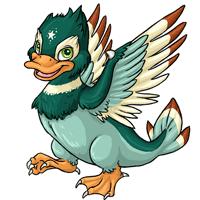


Mallarchy
(muh-LAR-kee)
Nearly every fresh body of water, no matter how big or small, is home to a mallarchy. This diverse waterbird is found all over Subeta - from quiet, isolated forest pools to city fountains and reservoirs. In fact, they are so wide-spread that it has led to a popular phrase around Subeta: when something is presented as unique or special, it is appropriate to respond with, "Well, it's not exactly a mallarchy, is it?"
Mallarchies are quite heavy for a bird. The male drakes are significantly bigger than the female hens, at a length of about 35 inches (89 cm) and weight of 10-15 lbs (4.6?6.8 kg). Hens average a modest 25 inches (63.5 cm) and 8-10 lbs (3.6-4.6 kg). Males tend to have a brighter marking on their head, as well as slightly larger claws on their elbows. The claws are used to scratch at the ground and sometimes to assist in nest-building, though mallarchies are rarely observed using them. Wild hens will lay a large clutch of eggs in the spring, often 10-16 eggs, which they then incubate for 30 days. Mallarchy chicks can vary in shades of yellow and brown, and they will spend anywhere from 8-12 weeks with their parents as they learn to swim, feed, and fly. They are quite a bit faster at swimming than flying, and their oddly-shaped tails serve as rudders to help them steer in water with great accuracy. Mallarchies do not migrate, but stay in nearly any climate year-round; they seem to have little regard for how cold water is, and flocks of mallarchies can even be observed sitting on frozen surfaces as if they are swimming!
Domestic mallarchies are proficient layers, and will have eggs throughout the spring, summer, and into early autumn, as long as they are provided with adequate space and good food. The average-size garden makes a perfect habitat for mallarchies, and they are quite popular as pets for both their eggs and companionship. Mallarchies are actually quite cuddly; similar to a feli, they often enjoyed being held and cuddled, and they can even be leash-trained! Pet mallarchies are also quite playful, and they can even be trained to use their tails as a racket for a unique game of catch. They will eat grasses, seeds, and small flying insects, and their diets can be supplemented with cracked corn. Having a place for them to swim and bathe is a must, and a large, plastic kiddy pool often serves this purpose well. Mallarchies are also highly valued as a source of food, and the meat of both wild and farmed mallarchies are readily available at markets all over Subeta.
Mallarchy has been viewed 3,022 times.
[Search]